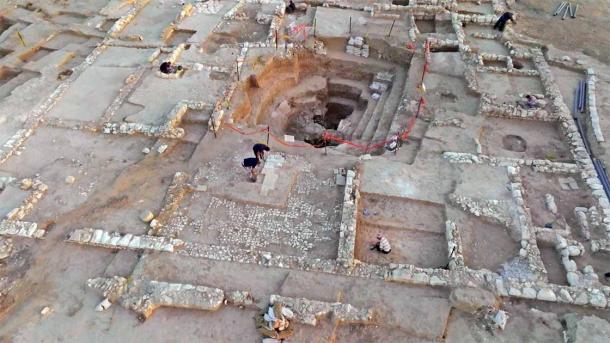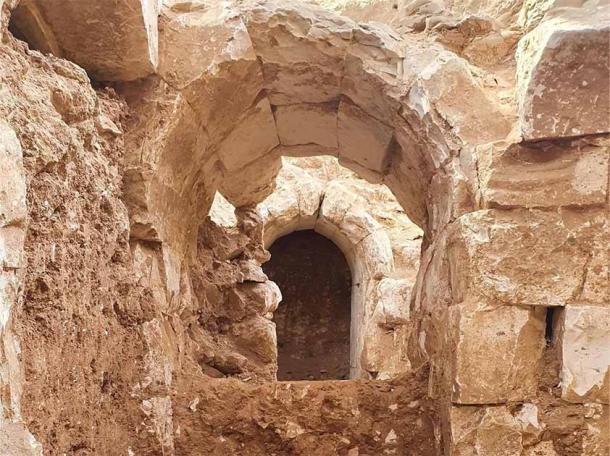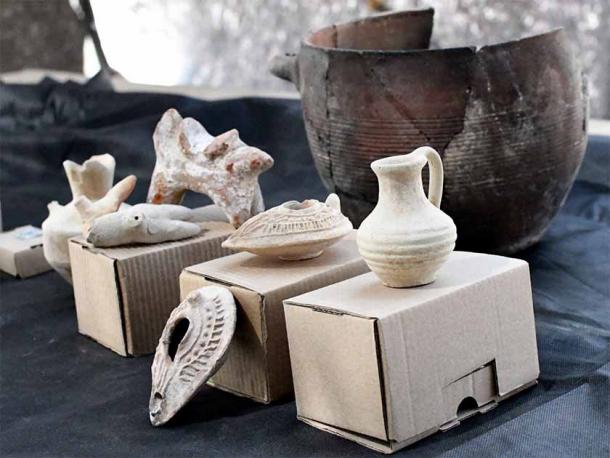
Lavish Early Islamic Mansion Found in Israel’s Negev Desert Astounds!
In the Bedouin town of Rahat, during pre-emptive excavations carried out before the building of a new neighborhood by the Israeli government, archaeologists stumbled upon a 1,200-year-old Islamic mansion. The 8th-9th century AD mansion is dated to the Early Islamic Period and is a first of its kind “luxurious rural estate,” which has never been seen before in the Negev desert region. It had originally been styled in the Roman-Byzantine fashion, indicating a change in the tastes of the owners over generations as they transitioned away from Christianity towards Islam.

An aerial view of the luxurious and large Islamic mansion, which had a unique subterranean chamber, recently uncovered in the Negev desert of Israel. (IAA)
A Unique Desert-world Islamic Mansion: Luxury and Fine Taste
In the Israel Antiques Authority statement, the three excavation directors Oren Shmueli, Dr. Elena Kogan-Zehavi and Dr. Noé D. Michael remarked that the mansion was proof of the high status and wealth of the owners. "We assume whoever lived here was some local ruler… such estates were totally unknown in the Negev until today," Dr. Michael’s said in an interview with AFP.
They were referring to the size of the luxurious Islamic mansion, its fine architecture, and the site’s unusual underground vaults. The mansion itself had four different wings to serve the familial and personal needs of its residents.
- Artifacts Reveal Out of Africa Route Through Negev Desert
- Humans and Neanderthals Met and Mated 50,000 Years Ago in Negev Desert

Part of the complex that has been excavated. (IAA)
The estate’s unique vaulted complex, which included a 3-meter (9.8-foot) deep rock-hewn water cistern, featured an exquisite central courtyard. The cistern was built in such a way that residents could move freely around its underground section, where they could escape the desert heat.
One of the Islamic mansion’s wings had a hall paved with marble and stone flooring, decorated with superb, small frescos. These frescos were in red, yellow, blue, and black, and the archaeologists managed to unearth parts of a wall with white coating over the original images. The rooms in the building had plaster floors. The rooms also housed large ovens. Shards of delicate glass serving dishes that were heavily decorated were also found, indicating that guests were frequently entertained at the estate.

These fine luxurious artifacts were found on the recently discovered Islamic mansion site in the Negev desert of Israel. (IAA)
Islamic Subterranean Complex and Its Religious Symbols
Most of the original 30 x 30 meter (98.4 x 98.4 feet) house is gone, according to a Haaretz report. Some parts of the original walls remain, some up to half a meter (1.6 feet) in height. The mansion’s most amazing feature was its underground vaulted chambers, 2.5 meters (8.2 feet) in height, that were built with locally quarried limestone. The courtyard cistern described earlier lay between two mosques.
This entire subterranean complex was built using the finest materials to create equally high-quality architectural features, indicating that it was an important part of the mansion itself.
- Does the Negev’s Ancient Rock-Art Help Turn the Bible Exodus Story into Fact?
- Boutique Wine for Byzantines: 1,600-year-old Wine Press Discovered in the Negev Desert
“They excavated six meters [20 feet] down to the bedrock and erected arches and tunnels in all directions, and in the bedrock they carved the cistern going down at least 3.5 meters [11.5 feet]. It was a technological feat,” said Dr. Michael. In comparison to this Islamic mansion, subterranean complexes in the Negev region were usually crudely cut into soft sedimentary rock found in the region.
The marble used for this construction, both below and above the ground, was not locally produced, but not imported from far away either. It was probably repurposed from destroyed Christian buildings, as evidenced from the remnants of a marble cross found at the site.
Images of the Star of David (or the Seal of Solomon) indicated that the Islamic people living in the Negev region had co-opted Solomon’s seal as part of their religious beliefs. In Islam, Solomon was a powerful prophet, whose symbol represented fighting the evil eye.
In June 2022, just a stone’s throw away from the Islamic mansion, a mosque from the same period was discovered. Three years prior to that, another mosque, roughly dated to 7th-8th century AD, was unearthed in the Negev desert region. All of these finds, say archaeologists, show the Islamization of the region, an important development in the settlement of Western Asia and the Arabian Peninsula.
Eli Eskosido, Director of the Israel Antiquities Authority, said, “By good chance, and much to the local population’s interest and excitement, the building remains uncovered in the area planned for expanding the town of Rahat date to the Early Islamic period. The Israel Antiquities Authority and the Authority for the Development and Settlement of the Bedouin are planning together to conserve and exhibit the finds to the general public.”
The IAA added that on Thursday that the site would be open to the public, including family digging and sieving activities.
Top image: The luxurious Islamic mansion found in the Negev desert also had a substantial subterranean portion, as this image reveals. Source: IAA
By Sahir Pandey
References
AFP. 2022. Israel unveils 1,200 year-old desert mansion. Available at: https://www.france24.com/en/live-news/20220823-israel-unveils-1-200-year-old-desert-mansion.
Rose, E. 2022. Luxurious 1,200-year-old mansion found in southern Israel. Available at: https://www.newsnationnow.com/science/luxurious-1200-year-old-mansion-found-in-southern-israel/.
Schuster, R. 2022. Early Islamic Mansion With Unique Subterranean Complex Discovered in Israel. Available at: https://www.haaretz.com/archaeology/2022-08-23/ty-article-magazine/early-islamic-mansion-with-unique-subterranean-complex-discovered-in-israel/00000182-ca2b-df45-a7b3-da6bbdff0000.















